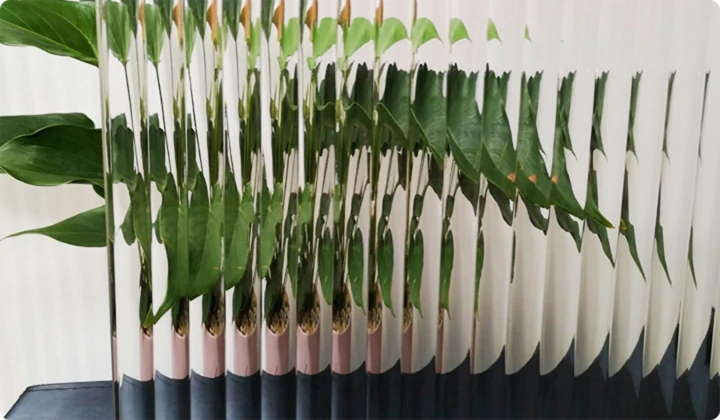Exploring Textured Glass Patterns A Fusion of Art and Functionality
In the realm of architectural design and interior decoration, textured glass patterns have emerged as a captivating element that seamlessly blends aesthetics with utility. From grand buildings to cozy homes, the incorporation of textured glass not only enhances visual appeal but also offers a myriad of practical benefits. This article delves into the fascinating world of textured glass patterns, exploring their types, applications, and the artistry behind them.
Textured glass refers to glass that has been treated to create a distinct surface pattern. This can involve etching, sandblasting, or molding the glass during manufacturing processes. The resulting textures can range from subtle ripples to intricate geometric designs, each serving unique purposes. Common patterns include frosted, reeded, patterned, and embossed glass, each providing different levels of privacy and light diffusion.
One of the primary advantages of textured glass is its ability to diffuse light while maintaining a level of privacy. Homes and offices often utilize frosted glass for bathroom windows or office partitions, allowing natural light to stream in while obscuring views from the outside. This is particularly important in urban environments where privacy can be a concern. The soft, diffused light that emerges from textured glass creates an inviting atmosphere, making spaces feel brighter and more open.
In commercial settings, textured glass patterns serve both functional and aesthetic roles. Shops and storefronts often employ patterned glass show windows to attract attention. The unique patterns not only draw customers in but also allow for some privacy for the products displayed. Additionally, textured glass can help reduce glare, making it easier for passersby to see the items within without being blinded by direct sunlight.
textured glass patterns
Architects and designers are continually pushing the boundaries of what textured glass can achieve. Innovations in glass design have led to the creation of dynamic surfaces that change appearance depending on the angle of light. For instance, iridescent glass techniques can create stunning visual effects that shift colors as one moves around the installation. These advancements open up new creative opportunities, enabling designers to craft spaces that are equally functional and visually striking.
Moreover, textured glass patterns are becoming increasingly prevalent in the development of energy-efficient buildings. Glass with specific textures can contribute to better thermal insulation. By incorporating textured inflections that scatter sunlight, buildings can reduce their reliance on artificial lighting and temperature control systems. In this way, textured glass not only elevates the design of a structure but also supports sustainability goals.
The artistic aspect of textured glass cannot be overlooked. Many artisans create custom designs that reflect personal styles or thematic elements. This craftsmanship brings a unique character to spaces, allowing for the expression of individuality. From elaborate stained glass windows in historical churches to minimalist designs in modern homes, the scope of artistic expression through textured glass is virtually limitless.
As public awareness of the aesthetics and functional advantages of textured glass grows, so does the demand for this medium. It's now commonplace to see textured glass being used in residential spaces, outdoor patios, and even in outdoor furniture, where durability and beauty are both essential. The versatility of textured glass patterns means they can easily adapt to various styles, from contemporary to traditional, making them an ideal choice for any design project.
In conclusion, textured glass patterns represent a beautiful melding of art and functionality. Their ability to enhance light diffusion, provide privacy, and contribute to energy efficiency makes them an essential material in modern design. As technology continues to evolve, we can expect to see even more innovative applications of textured glass in architecture and interior design, further enriching the environments we inhabit. Whether you’re an architect, designer, or simply an enthusiast of beautiful spaces, the enchanting world of textured glass is one worth exploring.
 Afrikaans
Afrikaans  Albanian
Albanian  Amharic
Amharic  Arabic
Arabic  Armenian
Armenian  Azerbaijani
Azerbaijani  Basque
Basque  Belarusian
Belarusian  Bengali
Bengali  Bosnian
Bosnian  Bulgarian
Bulgarian  Catalan
Catalan  Cebuano
Cebuano  Corsican
Corsican  Croatian
Croatian  Czech
Czech  Danish
Danish  Dutch
Dutch  English
English  Esperanto
Esperanto  Estonian
Estonian  Finnish
Finnish  French
French  Frisian
Frisian  Galician
Galician  Georgian
Georgian  German
German  Greek
Greek  Gujarati
Gujarati  Haitian Creole
Haitian Creole  hausa
hausa  hawaiian
hawaiian  Hebrew
Hebrew  Hindi
Hindi  Miao
Miao  Hungarian
Hungarian  Icelandic
Icelandic  igbo
igbo  Indonesian
Indonesian  irish
irish  Italian
Italian  Japanese
Japanese  Javanese
Javanese  Kannada
Kannada  kazakh
kazakh  Khmer
Khmer  Rwandese
Rwandese  Korean
Korean  Kurdish
Kurdish  Kyrgyz
Kyrgyz  Lao
Lao  Latin
Latin  Latvian
Latvian  Lithuanian
Lithuanian  Luxembourgish
Luxembourgish  Macedonian
Macedonian  Malgashi
Malgashi  Malay
Malay  Malayalam
Malayalam  Maltese
Maltese  Maori
Maori  Marathi
Marathi  Mongolian
Mongolian  Myanmar
Myanmar  Nepali
Nepali  Norwegian
Norwegian  Norwegian
Norwegian  Occitan
Occitan  Pashto
Pashto  Persian
Persian  Polish
Polish  Portuguese
Portuguese  Punjabi
Punjabi  Romanian
Romanian  Russian
Russian  Samoan
Samoan  Scottish Gaelic
Scottish Gaelic  Serbian
Serbian  Sesotho
Sesotho  Shona
Shona  Sindhi
Sindhi  Sinhala
Sinhala  Slovak
Slovak  Slovenian
Slovenian  Somali
Somali  Spanish
Spanish  Sundanese
Sundanese  Swahili
Swahili  Swedish
Swedish  Tagalog
Tagalog  Tajik
Tajik  Tamil
Tamil  Tatar
Tatar  Telugu
Telugu  Thai
Thai  Turkish
Turkish  Turkmen
Turkmen  Ukrainian
Ukrainian  Urdu
Urdu  Uighur
Uighur  Uzbek
Uzbek  Vietnamese
Vietnamese  Welsh
Welsh  Bantu
Bantu  Yiddish
Yiddish  Yoruba
Yoruba  Zulu
Zulu 

